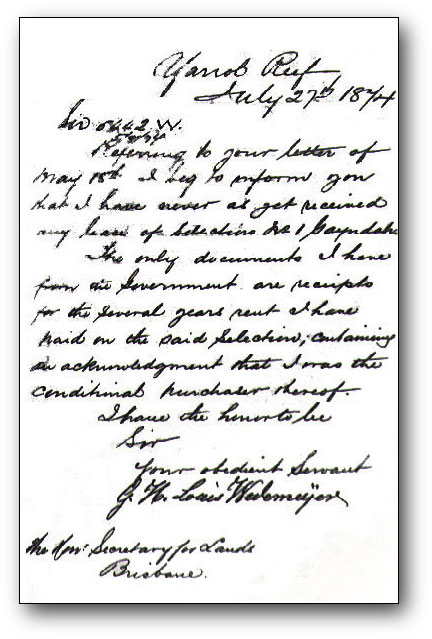Contents of this Website are subject to Copyright © by Philip Strong, & allow fair academic use. See here.
Do you have information, opinion or a question relating to either this site’s contents or its copyright? Please use the e-mail link available at the bottom of each page. I look forward to corresponding with you.
A letter written by GHL WEDEMEYER
… compared with Goslar & Moringen Registers.
Please note the apparent Ÿ umlaut in Wedemeÿer, in both the letter and the Registers shown below.
 Letter to Minister for Lands: GHL WEDEMEYER, 27 Jul 1874.
Letter to Minister for Lands: GHL WEDEMEYER, 27 Jul 1874. Land Selection file, Queensland State Archives.
German linguists— please note: senior lecturers in two Australian German University Departments have told me that the apparent Ÿ umlaut in Wedemeÿer is not an actual umlaut, and thus would not change the sound of the "Y". Moreover, they said it was a "scriptal flourish " (ornamentation), which was in early German use. Copies of the Goslar & Moringen church registers (see beneath) show that the family recorded their surname as Wedemeÿer (with an apparent Ÿ umlaut) when GHL was baptised, when his parents were married and also when his grandfather died (even allowing for fly specks on the old registers and the copying processes).
GHL’s surname received an unusual pronunciation in Gayndah, Australia. Should we play safe and accept the view of acknowledged experts in their field? This would probably mean that the people of Gayndah (including GHL’s own daughter) had difficulty with unfamiliar German phonemes, and their pronunciation had nothing to do with Ÿ umlauts!
Have a look at their pronunciations, which involve the considerable distortion of the pronunciation of the "Y" in the German "meyer" from the expected "mire" ("wĕd-eh-mī-ur") to "mere" ("wĕd-eh-mĭ-ur")!
Note: The description of pronunciation presents difficulties. The International Phonetic Alphabet would be the least ambiguous, though some symbols could not be reproduced in HTML, and the phonemic notations would create difficulties for many readers. Accordingly, I have described the length of vowels with short " ĭ " and long " ī " symbols, simultaneously referring to words with known pronunciation … eg. "-mī-ur" as in "mire". Any suggestions for better presentation would be gratefully received.
Let’s now try a "what if"? What if GHL was applying an actual umlaut which changed the vowel sound, and not just a scriptal flourish. The family name certainly used a scriptal flourish in the Goslar and Moringen church registers… see the extracts below. If it were an effective umlaut, it could be an application of a mediaeval Hanoverian Plattdeutsch dialect, even though I am told that the current language in Goslar is totally Hochdeutsch? This would mean that the local Gayndah residents’ unusual pronunciation of WEDEMEYER might have been a copy of GHL’s own pronunciation, indicating that some early German pronunciations are still in an area of some academic uncertainty? I would be interested in your comments.
 Church Register Entries showing Ÿ umlaut (apparent) in WEDEMEYER… from top to bottom:
Church Register Entries showing Ÿ umlaut (apparent) in WEDEMEYER… from top to bottom: Marriage of GHL’s Parents (Goslar). GHL’s Baptism (Goslar). Death of GHL’s Grandfather (Moringen)
Rejoin the Story:
- Return to: Chapter 3: Gayndah
- Or continue on to: Chapter 4: Drummers Creek